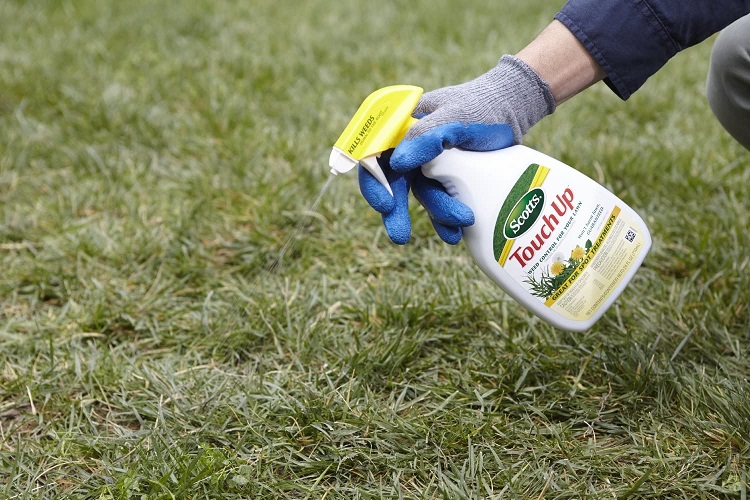- How to Get Rid of Spurge Weed - December 24, 2021
- Guide to Craftsman LT2000 Parts: Where to Find Them Online? - July 15, 2021
- The Best Time to Spray Dandelions: Tips, Tricks and More - January 9, 2021
Dandelions are frequently associated with springtime, regardless of whether they’re actually desirable or not. They’re bright yellow and they look chipper, but they’re often the source of quite a bit of neighborhood shame.
If you’re struggling to get rid of your dandelions, there are some things you may need to know about spraying. There are right and wrong ways to do it. First, you need to understand dandelions and how they work.
What are Dandelions
Dandelions are weeds. Their lifecycle is what makes getting rid of them so hard. While two other common weeds, henbit, and chickweed, are winter annuals and germinate in the cool conditions of late September and October, dandelions are different.
Dandelions are perennials. Perennial plants come back year after year. One plant will persist in your yard (and spread!) for years before you terminate it completely. New seeds germinate every fall and will flower from late winter through the spring.

By the spring, when they start popping up, homeowners are frustrated and want them gone. But by then, it’s already too late. You can’t achieve control of something that’s already widespread.
You have to start early, treat it effectively, and know what you’re doing. By spraying only in the spring, homeowner’s waste their money on these applications, and risk ruining their entire lawn by overspraying.
The Problem
Every plant’s goal is to reproduce. Once a dandelion has flowered, it does everything it can to ward off the herbicide you spray on it. It may be distorted or stunted after you spray it, but it will still continue to flower and spread its seed.
As you spray your herbicide willy nilly throughout your lawn in a fruitless attempt to control your dandelions, the herbicide spray drifts through the air and onto your other fragile plants. The result is stunted and abnormal growth for your other beautiful trees, shrubs, and flowers.
If it’s too late in the season to spray, your best bet for controlling dandelions is to either wait until the fall, or get down on your hands and knees with a sharp knife and dig them out. It’s a lot of work, so it’s up to you whether it’s worth it or not.
Best Time to Spray
Treat your dandelions with an herbicide in the fall. Late October through mid-November is ideal. Mark your calendar for around Halloween, and you can tackle both henbit and chickweed at the same time so it won’t return next year either.
Around this time of year, dandelions are only very small seedlings, just developing. Any herbicide you get over the counter will kill them before they can reach the flowering stage.
If you have a large dandelion problem, a blanket spray over your entire lawn may be the best solution. However, you can also spot treat your lawn for dandelions if you simply want to target the areas where the dandelions are growing.

Not only is fall the perfect time for targeting dandelions because of their lifecycle, but your other delicate plants are at a stage in their cycle where they’re much more resistant to injury. It’s likely that the frost has already sent them into hibernation.
You won’t have to worry about them absorbing any of your herbicide, which means you’re only doing damage to the weeds you don’t want to return. Fall is also a much less busy time for gardening, so you should be able to work it in, freeing you up for planting in the spring.
How to Spray
Unfortunately, there really aren’t any good organic dandelion killers. You may have some luck with organic dandelion sprays if you keep at it and you’re diligent about spraying repeatedly, but it will take a lot longer.
If you’re truly wanting to get rid of the pesky buggers quickly, you’re going to have to use a chemical solution. The most effective dandelion control on the market right now are herbicides containing 2,4-D.
As with all chemical substances, you have to be very careful while using it. Read the label before applying it to your plants, even weeds. It won’t injure your grass lawn, and if you do apply it in a blanket spray, it is incredibly effective at targeting every single dandelion in the yard.
Because dandelions so often grow better in shade, they’re harder to kill. Be aware that with the fall leaf covering of deciduous trees, you may have to do a considerable amount of raking before you spray.
The spray won’t work if it doesn’t come into contact with the dandelions directly. Cover the dandelions completely, and target areas where the dandelions grow the most. If you spray leaves covering the dandelions and then rake the leaves away, you won’t kill the dandelions.
Temperature Conditions
It’s best to spray after you’ve already had 1-2 frosts, but when the temperature is about 75 degrees. If you live in the Midwest, you know it’s highly likely to achieve this, even in late October or early November.
Watch the weather and make sure there’s no chance of rain for about 24-48 hours after spraying. The temperature can be lower, but it means the dandelions will die more slowly and some may not die at all.
If it rains, it could dilute the chemical compound, making it less effective. If the weather forecast makes it seem like there simply won’t be an ideal time to spray this fall, use a wetting agent or a household detergent.
You can use any household detergent at a rate of one teaspoon per gallon of spray. It can enable better coverage and better absorption, which means that, even in less than ideal weather conditions, you’ll achieve a better kill.
Which Weed Killer to Use
There are quite a few options, so it’s important to know the difference. From organic to chemical sprays and pre-emergent to post-emergent options, you need to know what to look for. If you don’t eliminate the entire plant, it will just come right back. However, there are plenty of benefits to using a dandelion spray.
Spraying them means they’ll stay away longer. It also makes it easier for you to get rid of them rather than pulling them all by hand. It doesn’t take as long as pulling them all by hand, either, and it’s more effective at getting rid of all of them.
However, what makes a dandelion killer great may depend on what you’re looking for. Here are your options.
Chemical or organic
Both of these have the potential to work well, depending on who you talk to. Chemical dandelion killers are more targeted, accurate, and quick. However, they can harm children and pets, so you have to stay off of the lawn for at least 24 hours after you spray.
You won’t see the effects of an organic spray as quickly, and it may take more applications for it to work. You’ll get the benefit of safety in using an organic spray by being able to walk on it immediately afterward. No worrying about allowing your children or pets outside. It’s completely safe.
Either way, you go, you risk making your neighbor mad. You’ll always have that one who either hates that you can’t seem to get rid of your dandelions or that you’re spraying chemicals in your yard.
Whichever you choose, a pump sprayer will help you mix your concentrates and apply them to the lawn. It makes for a faster and easier spreading process.
Pre-emergent or post-emergent
Both chemical and organic sprays come in pre-emergent and post-emergent options, so you’ll need to choose one. There’s a big difference between the two.
Pre-emergent sprays are used to spray seeds before they grow. You can interrupt the dandelion’s growing process and stop the issue before it really starts. You do this in the late fall. Pre-emergent sprays contain ingredients that stop dandelions from germinating.
You can get liquid or granular pre-emergent formulas. By following the instructions on the label, you’ll either mix it with water or apply it directly to the surface of your lawn. You may or may not need to water it into the soil to activate the ingredients.
Pre-emergent treatments are useless if your dandelions have already started to grow.
Post-emergent sprays can be used once your dandelions have already started growing. They contain ingredients that kill dandelions to ensure they don’t come back, but you can’t always ensure your dandelions won’t come back next year.
You saturate the ground at the base of the dandelion with post-emergent treatments and be sure you cover all exposed stems and leaves. If you’re using a mix that’s toxic, be sure to wear a mask and gloves. Protective gear is imperative to ensure you don’t come in direct contact with the solution.
Often, it’s more effective to use a mix of both a pre-emergent and a post-emergent treatment. Neither is 100% effective on its own, thanks to the effective proliferation of dandelions everywhere. However, you can do a pretty good job of treating your own lawn by using both and being persistent year after year.
Product durability
Using a solution that can handle all sorts of weather is important. If you live in a place where dandelions grow, you’re likely to experience shifts in weather during the times when you need to spray. It also allows you to spray when it’s convenient for you.
Some sprays can’t be used when it rains while others can’t be used if it’s too dry. It’s best to read reviews and follow the directions closely. Every dandelion kill will give you specific instructions on how and when to use is. You can save a lot of time and money by using it according to how it’s intended to be used.
Also make sure you can use it on all types of weeds and grasses. While you may be targeting dandelions, it’s nice to know it might take care of a lot of your other weed problems while not killing your grass. Multi-purpose killers are very effective if you have a weed problem.
Product Recommendations
If you’re looking for a dandelion killer, here are some really great options.
Espoma Organic Weed Preventer
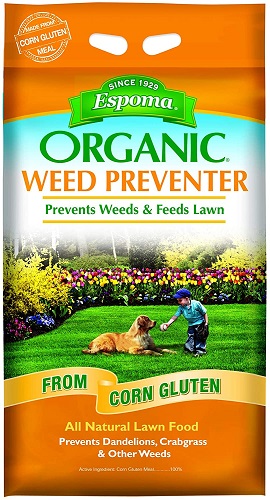
This is an organic pre-emergent granule that pours easily, so you can get a thorough application on your lawn, and it only kills seeds. There’s no need to worry about it attacking other plants in your flower garden. However, you can’t plant anything new if you’re going to treat, because it will target seeds.
It’s made from a corn gluten meal, which means it’s organic and safe. It will also feed your lawn, making it deep and green when it grows in the spring. It helps prevent weeds by stopping their root growth, but it’s intended to be a pre-emergent because once roots are established, it will actually become a fertilizer.
It’s safe to use with pets and children, safe to use on your lawn, and it can kill weeds and feed your lawn at the same time.
Pros:
- Safe and healthy
- Attacks weeds and interrupts root growth
- Brightens lawns
Cons:
- Only attaches to seeds
- Becomes a fertilizer if used too late
- Must apply in a thick layer
Green It Environmental Factor RTS Corn Gluten Weed Preventer
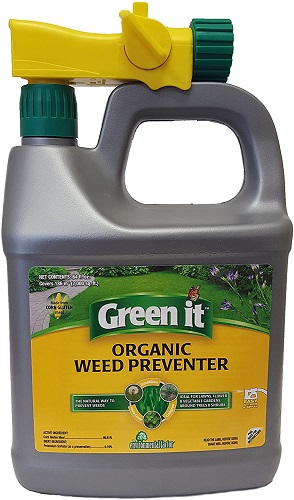
This product can cover up to 2000 square feet. The benefit of its packaging is that it already comes in a sprayer. It can target dandelions, clover, and crabgrass. It’s fast-acting and water-soluble, so you won’t have to worry about rain in the forecast.
It will cover more area in less product than a granular corn-based product, so you’ll be saving money on this over trying to spread granules in a heavy layer. It’s ideal for flower beds, around trees, and for covering entire lawns.
This particular product releases organic proteins that prevent the roots of weeds from stabilizing underground. It catches them before they latch on, meaning they go away and there’s less of a chance of them coming back. However, if you don’t use it exactly as it’s directed, it won’t work.
Simply attach your hose to the attachment, shake it up, and set the sprayer to the on position. Luckily, there’s no mixing involved, so you can go directly to spraying. The sprayer it comes with isn’t the best quality, so if you want to invest in your own sprayer, it may work a bit better.
Pros:
- Covers a lot of ground
- Safe for children and pets
- Lightweight and easy to spray
Cons:
- The sprayer doesn’t work well
- Clogs frequently
Southern Ag 2, 4-D Amine Weed Killer
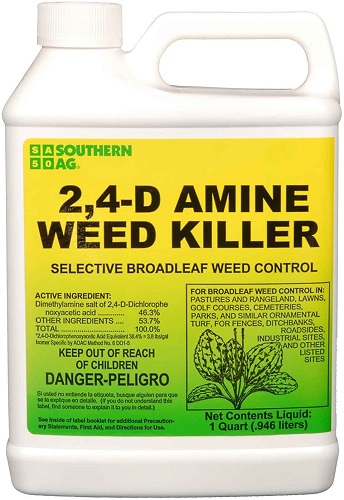
This is a post-emergent selective spray that you can use on any area of your lawn that already has weeds. It’s great for cracks in your driveway or even larger areas of your garden. It’s lightweight enough to carry around with you as you spray because it only weighs about 2.5 pounds.
Following the package directions will tell you that you don’t need to mix much of the solution with water to cover up to 1000 square feet of space. It also doesn’t take much pressure to apply the spray using the nozzle. You can use the fan-style sprayer to spray over an area several times to ensure coverage.
You may not see results for up to 2 weeks with this weed killer, so don’t get discouraged if you don’t see results right away. It also comes in a pretty small size, so you may need to buy several if you have a lot of space to cover.
Pros:
- Works well
- Lightweight
Cons:
- Small
- Takes time to work
Scotts Turf Builder Weed and Feed Fertilizer
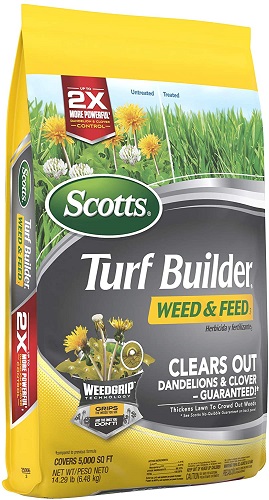
Scotts is one of the best brands in the lawn business. This post-emergent selective granule also helps to fertilize your lawn at the same time, so you’ll have a thick and luscious lawn without any weeds. It gets rid of weeds while providing nutrients to the other vegetation that should grow in their place.
The Scotts Builder Weed and Feed Fertilizer ensure that weeds are less likely to grow from thin spots again. Scotts uses a weed grip technology that attaches to weeds you can’t see so it can clean out dandelions and clovers while they’re still small. Many people see more results with this product than any other.
It seems to work best on a damp lawn, so you can use it after a rain or you can water your lawn before you use it. It will rid you of weeds, brighten your lawn, and make it look more healthy. Just make sure to follow the directions on the package so you get rid of your weeds without killing your lawn, too.
You’ll also want a different container to use for spreading because the container it comes in is pretty heavy.
Pros:
- Feeds and brightens
- Kills weeds effectively
Cons:
- Container is heavy
How Much to Use
The concentrations in each solution will vary greatly depending on which one you buy, so always follow the package directions. There’s no way to determine how much you should use based on any other criteria.
If there aren’t very clear package directions, the safe bet is to use one tablespoon of 2,4-D for every gallon of water. Check out our full guide on applying 2-4-D.
Gone Forever
Unfortunately, even if you manage to kill every single dandelion in your yard this fall, that won’t mean they’re gone forever. Well-meaning neighbors who don’t believe in spray, people who think dandelions are pretty, and kids who love to blow the fuzz are all working against you.
There’s always going to be someone who simply doesn’t care about the dandelions in their yard, and it doesn’t matter if they’re next door or 5 houses down and around the corner. The wind will manage to carry the seed back to your yard eventually, and you’ll find yourself spraying again.
However, a simple touch-up job every fall will keep it under control. A dry summer with thin grass and a skipped spray in the fall is all you need for dandelions to take root again and you’ll find yourself overwhelmed the next spring.
FAQ
Dandelions can be really frustrating and if you’ve never sprayed for them before, you may have a lot of questions about the process. These frequently asked questions should help you learn a little bit more.
We all know the weather can be finicky. Just because it’s late October, and you’ve already had two frost doesn’t mean it won’t warm up to 70 degrees again and you won’t still have to mow.
So, let’s say you spray for dandelions, and then your grass looks like it needs a good once over before putting away the mower for the winter. It’s safe to do so after 24-48 hours. You don’t want anything to disturb the herbicide or prevent it from proper absorption.
It’s also not safe for you to walk on it for about 24 hours, so it’s best to wait a day or two.
If you’re spraying for dandelions, you’ll want to keep people and pets away from the area for about 24 hours. This ensures that the herbicide has time to work and that no one has a reaction from coming into contact with the chemicals.
If you have pets or kids that need to go outside, spray your lawn in sections so you still have safe places for them to go out.
Unfortunately, no. You have to attack them before they bloom, or it’s already too late. You can always wait until the following year to spray for them, but you’re out of luck until then.
If they’ve already bloomed, your options are to mow over them or dig them out of the lawn. Mowing over them is the easiest thing to do, but it can also contribute to the spread of seeds.
Final Thoughts
If you have problems with dandelions, the best time to spray for them is in the fall. Don’t wait until you see them popping up or it’s already too late. Make sure you use a 2,4-D herbicide solution. You can try an organic compound, but it’s not likely to work very well.
Dandelions are pesky, and they come back every year, so it requires dedication and a touch-up treatment every fall, but if you keep after it, you’ll have a spotless lawn in no time.


